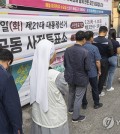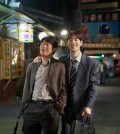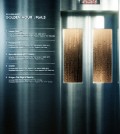- California Assembly OKs highest minimum wage in nation
- S. Korea unveils first graphic cigarette warnings
- US joins with South Korea, Japan in bid to deter North Korea
- LPGA golfer Chun In-gee finally back in action
- S. Korea won’t be top seed in final World Cup qualification round
- US men’s soccer misses 2nd straight Olympics
- US back on track in qualifying with 4-0 win over Guatemala
- High-intensity workout injuries spawn cottage industry
- CDC expands range of Zika mosquitoes into parts of Northeast
- Who knew? ‘The Walking Dead’ is helping families connect
National disgrace on tour
By Baek Byung-yeul, Kwon Ji-youn
Last year, a POSCO Energy executive was fired after physically assaulting a flight attendant for serving ramen noodles that he claimed were not fully cooked.
Criticism mounted against him even after he and the energy unit of steel giant POSCO issued public apologies. Media outlets lashed out at many other executives who have in the past caused havoc onboard aircraft and brought disgrace to the nation.
Yet only a few months later, Black Yak CEO Kang Tae-sun assaulted an Asiana Airlines employee for refusing him permission to board a domestic flight for which the deadline had passed.
Last year, the number of outbound tourists reached 13 million, and this year, the number is expected to reach 14 million.
But in 2012, Korea ranked sixth on the list of the world’s worst tourists according to a survey by LivingSocial and Mandala Research, which indicates that average tourists may be embarrassing the country, especially those who travel in large groups that fail to conform to the etiquette of other countries.
Etiquette on board
Etiquette must begin on the plane, says Yoo Dong-hyun, a medical school student.
“Being on a plane is like being in a different country,” Yoo said. “There are so many foreigners on board. You have to keep that in mind.”
Yoo recalled an incident in which a Korean woman was spotted returning to her seat from the toilet with a fistful of toothbrushes and toothpaste tubes. She had emptied the box of amenities there.
“When we were getting off, I saw the corner of a fleece airline blanket sticking out of her luggage,” he said. “One of the flight attendants saw it too, and asked her to leave the blanket behind, but the woman began raising her voice, claiming that the blanket cost was included in the ticket price.”
Yoo had spotted other Korean tourists wiping their feet with the pre-meal hand towels and lying down across three of the four center seats, even with the remaining aisle seat occupied.
“And he happened to be a foreigner, too,” Yoo said. “The Korean man’s feet kept touching the foreigner’s arm. He looked awfully uncomfortable. I wanted to say something, but I didn’t want to make a scene.”
Tourism indecency
Some Koreans behave indecently in a more hit-and-run manner. Such indecency became an issue in China last year, when the China National Tourism Administration issued a set of guidelines to set such tourists right. The aim was to improve the poor reputation of Chinese tourists abroad.
But Korean tourists are just as notorious when it comes to travel impropriety, especially those who scribble on walls of historic sites around the world.
“I visited the Munich Town Hall steeple a couple of years ago, and saw for myself the Korean scrawls on it,” said Chelsea Lee, an office worker. “I couldn’t believe that these people would do this, in a foreign country no less.”
Lee said the scrawls appeared to have been written by high school or college students who came with friends, perhaps on a class trip.
“I doubt that they would have done so if they been with their families,” she said. “If this is the case, teachers need to pay more attention to what their students are doing on field trips.”
Lee also remembers spotting Korean tourists take photographs at a world-renowned museum in Paris, right in front of a sign that read, “Please refrain from taking photographs.”
“It’s unbelievable,” she said. “It was totally embarrassing.”
Other Koreans ask fellow Koreans to let them jump the queue at amusement parks, Lee said.
“I was waiting in line at a Six Flags in Texas when a couple of Korean college students came up to us and asked if they could jump in behind us,” she recalled. “I didn’t even know them. They spoke in Korean, but it was obvious what they were doing.”
Traveling for sex?
Song Ji-yeon, a 26-year-old graduate student, remembers traveling to the Philippines on a package tour with 14 other Koreans.
“Some Koreans seem to think they are superior to Filipinos (or Filipinas),” she remarked. “I remember seeing fellow Koreans treat Filipina waitresses and store clerks with complete disrespect.”
Song, who attended college in New York City, said that Koreans who visit the Big Apple also mistreat minorities.
“And yet they never treat Caucasian waitresses in the same manner,” she said. “This has always bothered me.”
Some golf courses in the Philippines do not admit Korean golfers for this reason, according to Song.
“At one restaurant, I saw about five Korean men, perhaps in their 50s, who were with five young Filipinas,” she said. “It seemed that these men were touring the Philippines for sex. It was disgraceful.”
News reports earlier this year covered this phenomenon, in which stately Korean men in their late 40s and 50s walk hand in hand with young locals — some even in their teens.
This is a natural sight, they read. Ugly Koreans, they call them.
Only last week, a photograph of a celebrity and a Filipina went viral on Facebook, and many suspected that the actor had bought sex while traveling. Though he argued that the photographed woman was the wife of his tour guide, some netizens uploaded screenshots of the woman’s Facebook, which indicated that she was single and a dancer.
Comments on such news reports read, “Korean men travel to the Philippines to engage in sex tourism all the time. It’s not a big deal.”
But according to an official at the Philippine Department of Tourism in Korea, very few travel to the Philippines for such purposes.
“Some businessmen do travel to the Philippines for such services, but to be frank, there is not much we can do about it,” she said. “We do request that they refrain from doing so, as it can really affect both countries’ reputations, but that’s about all we can do.”


















Pingback: How To Cook Yeul Ramen | chicken -bbq recipes
Pingback: How To Cook Yeul Ramen | tips - how to cook
Pingback: How To Cook Yeul Ramen | pasta - lets cook spaghetti
Pingback: How To Cook Yeul Ramen | cooking sushi for beginners
Pingback: How To Cook Yeul Ramen | chicken - how to cook steak
Pingback: How To Cook Yeul Ramen | bolognese - all pasta recipes
Pingback: How To Cook Yeul Ramen | steaks -bbq recipes
Pingback: How To Cook Yeul Ramen | book - how to cook
Pingback: How To Cook Yeul Ramen | rolls - cooking sushi for beginners
Pingback: How To Cook Yeul Ramen | spaghetti - the ultimate pasta site
Pingback: How To Cook Yeul Ramen | buy - create your recipe book
Pingback: How To Cook Yeul Ramen | perfect asian dishes
Pingback: How To Cook Yeul Ramen | lobster -seafood luxury recipes